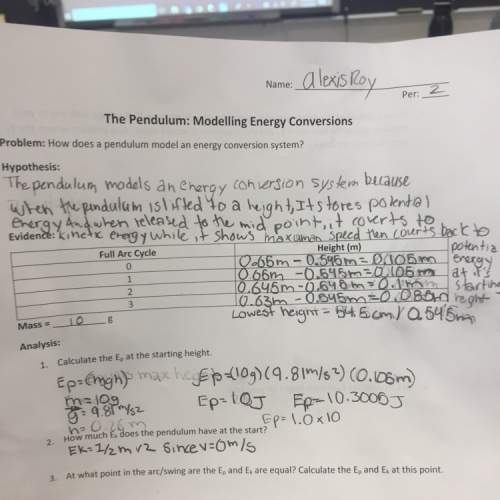
Physics, 14.07.2019 09:40 jones501324
An object with high momentum a. moves slowly b. moves fast c. resists change in its motion d. moves easily

Answers: 1


Another question on Physics

Physics, 22.06.2019 00:20
Consider the particle-in-a-box problem in 1d. a particle with mass m is confined to move freely between two hard walls situated at x = 0 and x = l. the potential energy function is given as (a) describe the boundary conditions that must be satisfied by the wavefunctions ψ(x) (such as energy eigenfunctions). (b) solve the schr¨odinger’s equation and by using the boundary conditions of part (a) find all energy eigenfunctions, ψn(x), and the corresponding energies, en. (c) what are the allowed values of the quantum number n above? how did you decide on that? (d) what is the de broglie wavelength for the ground state? (e) sketch a plot of the lowest 3 levels’ wavefunctions (ψn(x) vs x). don’t forget to mark the positions of the walls on the graphs. (f) in a transition between the energy levels above, which transition produces the longest wavelength λ for the emitted photon? what is the corresponding wavele
Answers: 1

Physics, 22.06.2019 01:20
Abanked road comer of radius 146 m is to be constructed. if the comer is designed for vehicles moving with a speed of 20.0 m/s, what should the banking angle be, in units of degrees?
Answers: 3

Physics, 22.06.2019 19:40
Uranium has two naturally occurring isotopes. 238u has a natural abundance of 99.3% and 235u has an abundance of 0.7%. it is the rarer 235u that is needed for nuclear reactors. the isotopes are separated by forming uranium hexafluoride uf6, which is a gas, then allowing it to diffuse through a series of porous membranes. 235uf6 has a slightly larger rms speed than 238uf6 and diffuses slightly faster. many repetitions of this procedure gradually separate the two isotopes. what is the ratio of the rms speed of 235uf6 to that of 238uf6? express your answer to five significant figures.
Answers: 3

Physics, 22.06.2019 20:40
Ablock of mass m = 2.5 kg is attached to a spring with spring constant k = 740 n/m. it is initially at rest on an inclined plane that is at an angle of theta= 26 with respect to the horizontal, and the coefficient of kinetic friction between the block and the plane is uk = 0.17. in the initial position, where the spring is compressed by a distance of d = 0.16 m, the mass is at its lowest position and the spring is compressed the maximum amount. take the initial gravitational energy of the block as zero. the block's initial mechanical energy is 9.472 j.b. if the spring pushes the block up the incline, what distance l in meters will the block travel before coming to rest? the spring remains attached to both the block and the fixed wall throughout its motion.
Answers: 3
You know the right answer?
An object with high momentum a. moves slowly b. moves fast c. resists change in its motion d. moves...
Questions

Chemistry, 13.10.2020 14:01

Mathematics, 13.10.2020 14:01


English, 13.10.2020 14:01

Social Studies, 13.10.2020 14:01


Mathematics, 13.10.2020 14:01



Mathematics, 13.10.2020 14:01

Mathematics, 13.10.2020 14:01





Mathematics, 13.10.2020 14:01

Biology, 13.10.2020 14:01

English, 13.10.2020 14:01







